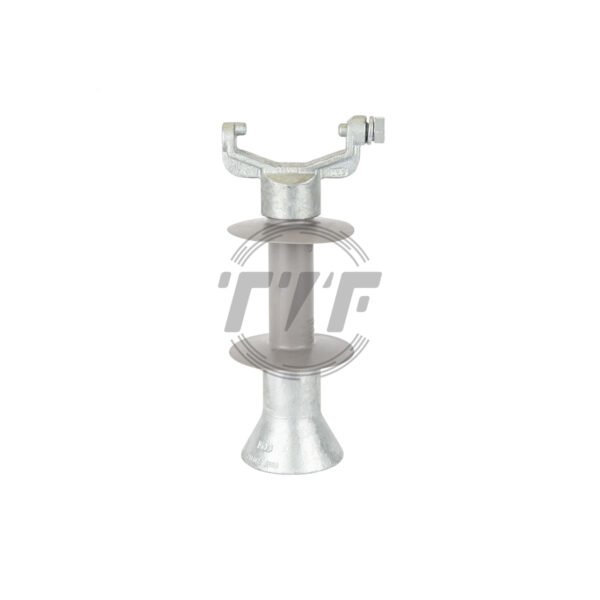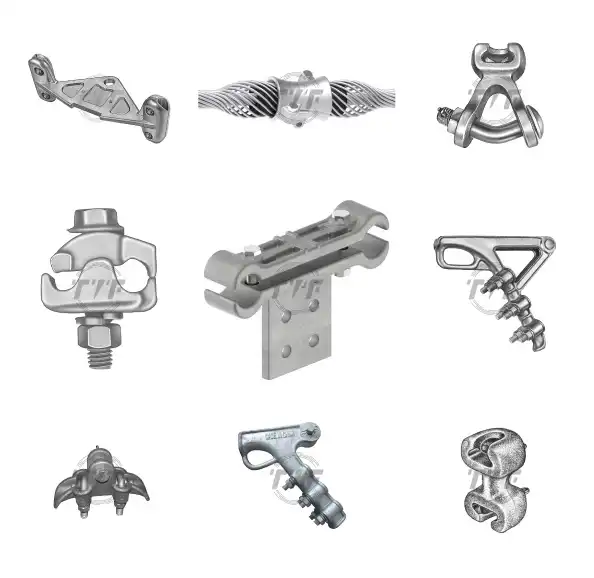A line post insulator is a type of electrical insulator used in overhead power lines to support and insulate conductors. It does this while maintaining mechanical strength and electrical clearance from grounded structures like utility poles. Line post insulators are crucial for maintaining the integrity and safety of power transmission and distribution systems. The insulators are able to withstand mechanical loads from conductors. They have a solid core with weather sheds, a mounting base for attachment to crossarms, and top groove clamps to hold the conductors. The insulators also have high dielectric strength to prevent flashovers and creepage distance for pollution-prone areas. Each design varies based on voltage levels, environmental conditions, and mechanical load requirements. Line post insulators are applicable in distribution lines (11 kV-33 kV), transmission lines (up to 765 kV), substations, and railway electrification.
Line Post Insulator
A line post insulator is a high-strength insulating device used in overhead power line construction to support and isolate conductors on transmission and distribution poles, typically in horizontal or vertical mounting configurations. Designed for medium to high voltage systems, it ensures mechanical stability and electrical insulation, even under severe environmental and loading conditions.
Key Features:
- High dielectric strength for voltage levels up to 69 kV
- Robust mechanical load capacity for tension and cantilever stress
- Ribbed design to increase creepage distance and prevent flashover
- Available in porcelain and polymer (composite) materials
- Resistant to UV radiation, moisture, and pollution
- Suitable for vertical, horizontal, or angled mounting
- Meets ANSI, IEC, and NEMA standards
Importance of using post insulators in overhead power transmission
Line post insulators ensure the safe, reliable, and efficient operation of overhead power transmission and distribution systems. The insulators isolate conductors from supporting structures to prevent unwanted current flow. Its high dielectric strength withstands high voltages and prevents flashovers. Line post insulators have mechanical strength that supports conductor weight, resists cantilever forces, and is suitable for higher mechanical loads. These insulators are suitable at turning points or dead-end structures where conductors exert horizontal tension. Line post insulators are rigid to improve stability in windy areas. Additionally, they are compact and mount vertically or horizontally on poles, which makes them suitable for urban or space-constrained environments. These insulators function in rural distribution networks, pole-top switchgear assemblies, and compact line designs in cities.
Working of a line post insulator
A line post insulator works by mechanically supporting the overhead conductor and electrically insulating it from the grounded support structure. Its rigid design allows it to withstand mechanical loads while maintaining electrical integrity under various environmental and load conditions. For the mechanical function, the conductor clamps to the top or side of the insulator, and the insulator is rigidly mounted on poles. It resists the mechanical forces acting on the conductor, including line tension, wind pressure, ice load, and vibration. Electrically, the insulator prevents electrical current from passing through the conductor to the pole. Its insulating material provides high dielectric strength to withstand high voltages without breaking down. The creepage distance is long enough to prevent flashovers in various conditions. The insulator prevents arcing and flashovers between the conductor and the grounded pole. Its solid core supports both the vertical weight of the conductor and lateral tension at angles.
Key features of the line post insulators
High-quality insulators providestrong mechanical support and superior electrical insulation. It is a crucial component in medium- to high-voltage overhead transmission and distribution systems. Its design and material versatility make it ideal for a wide range of utility applications. Line post insulators feature a rigid core, high mechanical strength, and superior electrical insulation. Their weather resistance and mounting versatility make them ideal for overhead power line applications. The key features include
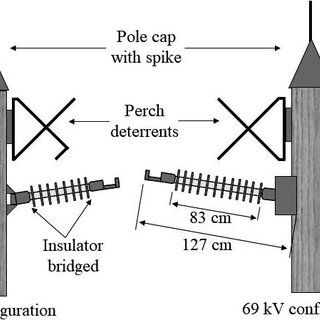
- Rigid core structure—the insulator is mainly built with a solid core, which makes the insulator non-flexible. This rigidity ensures it can support conductors in fixed positions at angles, dead ends, and straight runs.
- High electrical insulation—the line post insulator provides dielectric strength to withstand system voltages and prevent electrical leakage. It has a long creepage distance to improve surface insulation.
- Durable insulating materials—porcelain insulators have high compressive strength and resistance to weathering. Glass insulators have high visibility for damage detection and strong dielectric properties.
- Versatile mounting options—the insulator can install in vertical, horizontal, or angled positions on pole tops, crossarms, and steel or concrete towers. It allows use in different network configurations.
- High mechanical strength—the insulator withstands loads from conductor tension, wind pressure, and ice buildup. It is ideal for areas with high wind speeds or frequent line angles.
- Weather and pollution resistance—the surface design allows water to run off and reduces the risk of flashovers. It makes the insulator resistant to UV radiation, rain and snow, salt spray, and industrial pollution.
- Conductor compatibility—the insulator has top grooves or clamping points for securing various types of conductors.
Types of line post insulators used in overhead power lines
Porcelain line post insulators
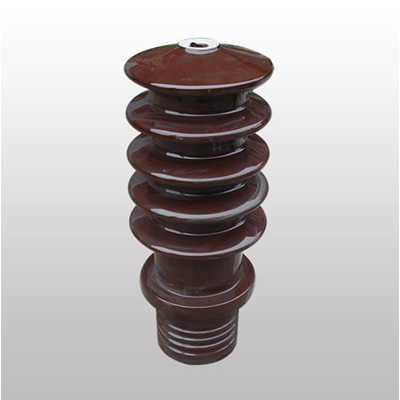
Porcelain is a high-grade ceramic with a glazed surface. Its structure has a solid core with a ribbed design to increase creepage distance. It also has metal end fittings for mounting. It has excellent mechanical and electrical strength and resistance to high temperature and UV degradation. The insulator serves in medium-voltage distribution lines, transmission lines, and substation bus supports.
Glass line post insulators
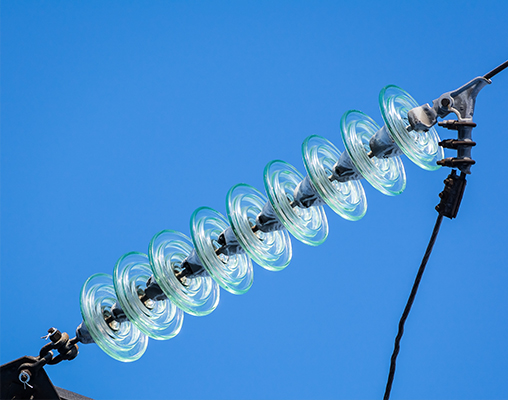
These insulators include tempered glass and are transparent or slightly tinted with a smooth surface. It is self-cleaning, has no internal defects, and has high dielectric strength like porcelain. Glass post insulators function in distribution lines and railway electrification.
Composite line post insulators
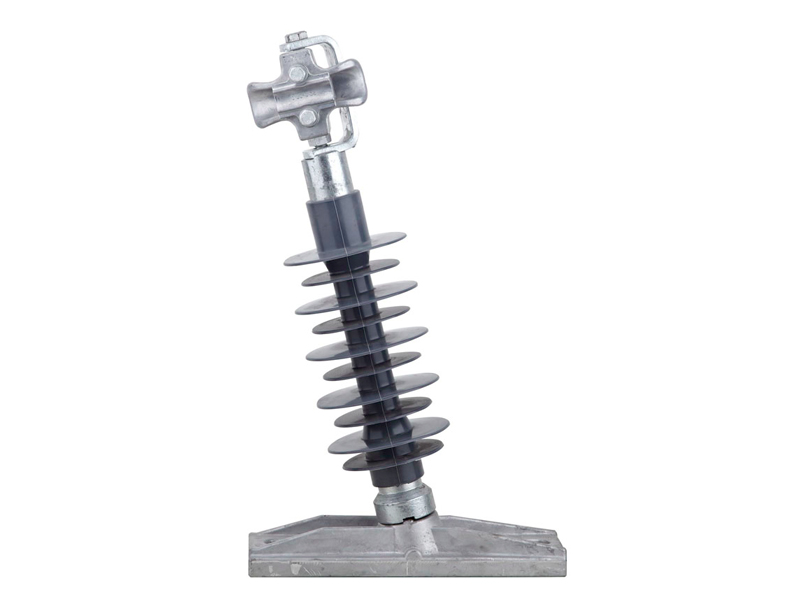
These insulators have a fiberglass-reinforced polymer rod with silicone rubber sheds. The insulator has high-strength fiberglass for mechanical load and silicone rubber for hydrophobicity and pollution resistance. It serves HV & EHV transmission lines, polluted environments, and urban distribution networks.
Hybrid line post insulators
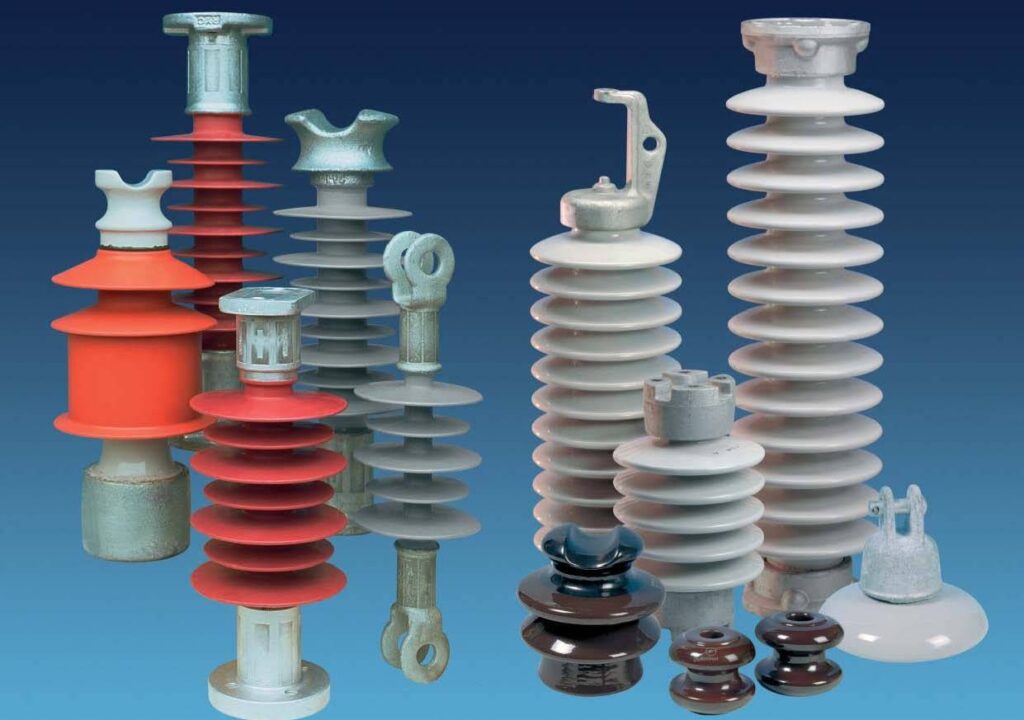
These insulators combine a porcelain core with polymer sheds, where porcelain provides mechanical strength and polymer sheds improve pollution performance. It functions in high-pollution and high-temperature regions.
Angled line post insulator
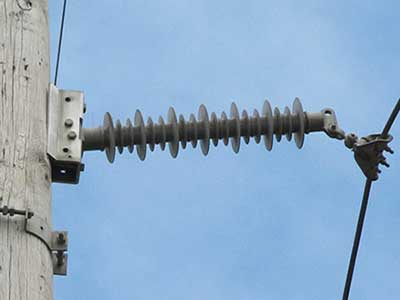
Angled insulators install at angled positions to support conductors where the line changes direction. It is also designed to handle asymmetrical tension forces. It is ideal for corners, directional changes, and load transitions.
Top-mounted post insulator
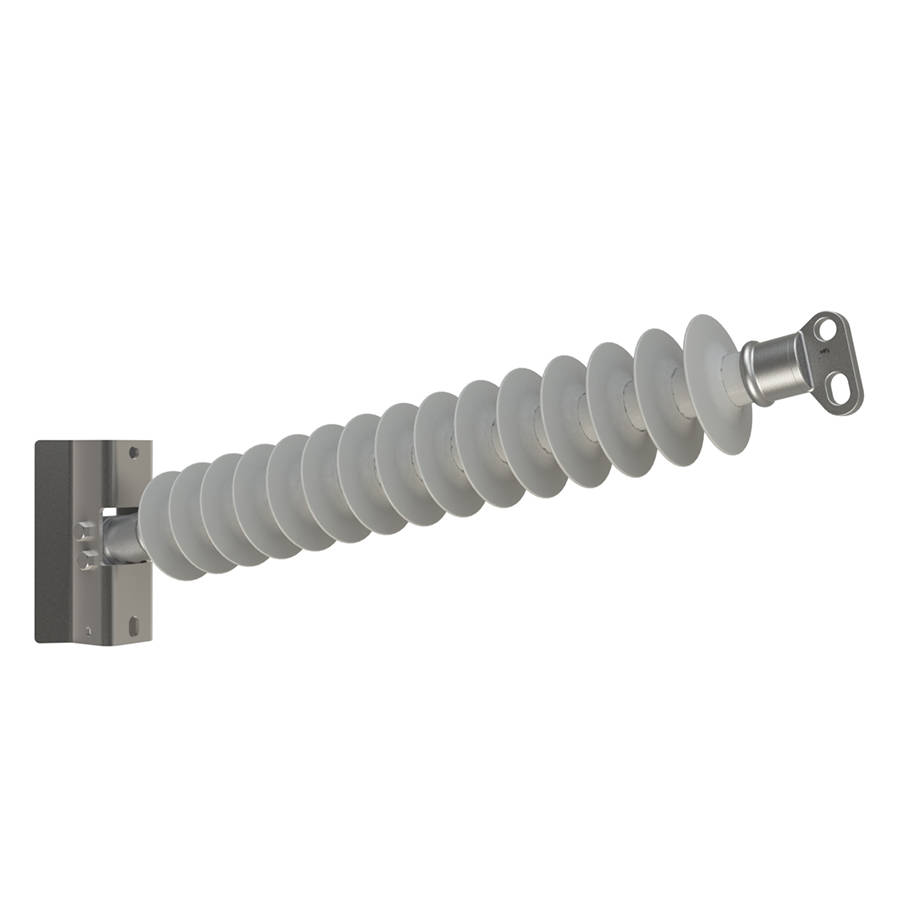
This mounts on the top of poles or structures and is used for straight-line sections. It provides strong vertical and lateral support. These insulators are ideal for standard line routing and open spaces.
Design and materials for post insulators in overhead power lines
The materials and design of a line post insulator are critical to its performance in overhead power lines. The insulators must resist mechanical stress, electrical surges, and environmental conditions. This is while providing safe and reliable support for live conductors. Common materials for line post insulators include polymer, glass, and porcelain. Using such materials provides mechanical strength and environmental resistance. The design components include:
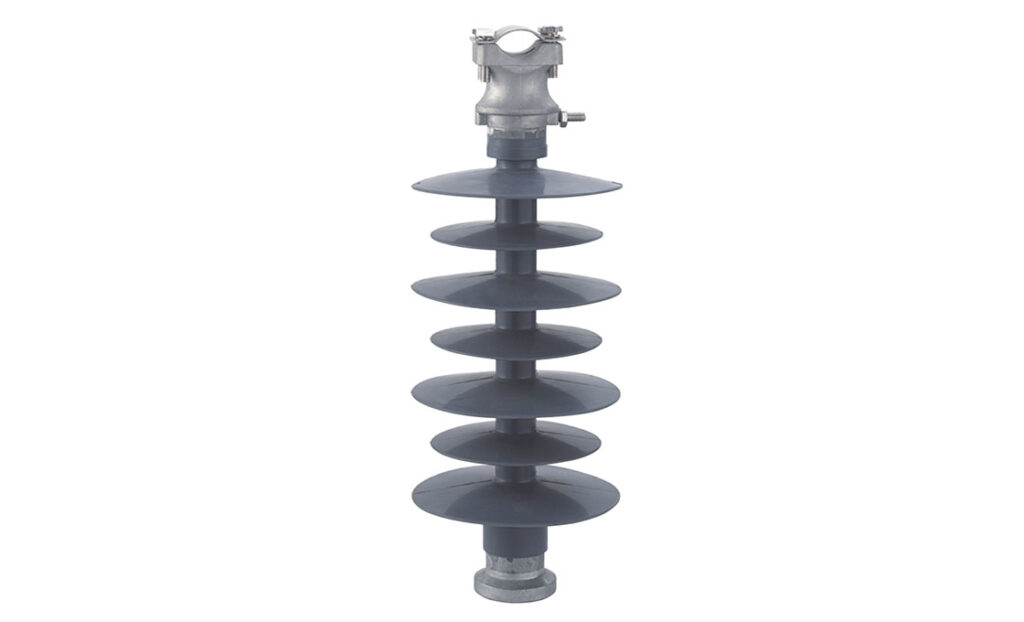
- Solid core construction—this is a rigid core that provides mechanical strength to resist conductor tension and wind forces.
- Shed profile—the sheds or ridges are able to increase creepage distance and improve self-cleaning in rain and resist flashover in wet or dirty environments.
- Mounting base and clamping head—these are metal end fittings that allow for bolting the insulator to poles or crossarms. The head has grooves or clamp interfaces for tie wires, mechanical clamps, and conductors.
- Standardized dimensions—the insulators follow ANSI or IEC standards to ensure interchangeability, safe clearance, and consistent performance across systems.
- Vandal-resistant design—this is a smooth, flexible surface with no brittle parts that make it harder to damage.
- End fittings—the top fittings secure the conductor through a groove, clamp, or ball socket. The base fitting bolts to the crossarm or structure. It is from materials such as hot-dip galvanized steel and ductile iron.
Functions of electrical insulators in overhead power lines
Line post insulators serve as critical components in overhead power lines, providing mechanical support for conductors and providing electrical insulation between wires. Their design and material properties enable safe and efficient power transmission and distribution. The insulators maintain conductor alignment, resist environmental stress, and ensure electrical safety. Its functions in overhead power lines are as discussed below.
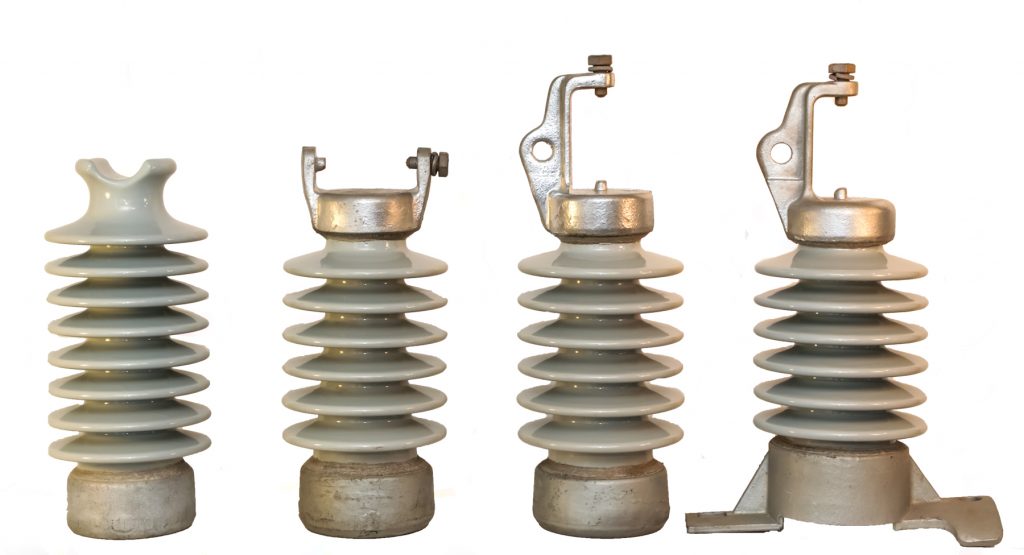
- Mechanical support of conductors—line post insulators physically hold and support overhead conductors to keep them aligned across the towers. They resist mechanical loads such as line tension, wind pressure, and ice accumulation. They also maintain proper spacing between conductors and other structural elements.
- Electrical insulation—they insulate live conductors from the grounded support structures like poles and towers. They prevent current leakage, withstand high voltage stresses, and avoid flashovers.
- Withstanding environmental stress—their materials and shed designs prevent surface tracking and erosion to ensure long-term reliability.
- Maintaining conductor clearance—the insulators secure conductors at a height to help prevent electrical arcs between adjacent lines. They also help prevent accidental contact.
- Support at line angles and dead ends—line post insulators withstand lateral and angular forces. They serve as angle poles and dead-end poles where higher mechanical tension is present.
Best practices for insulators in overhead power lines
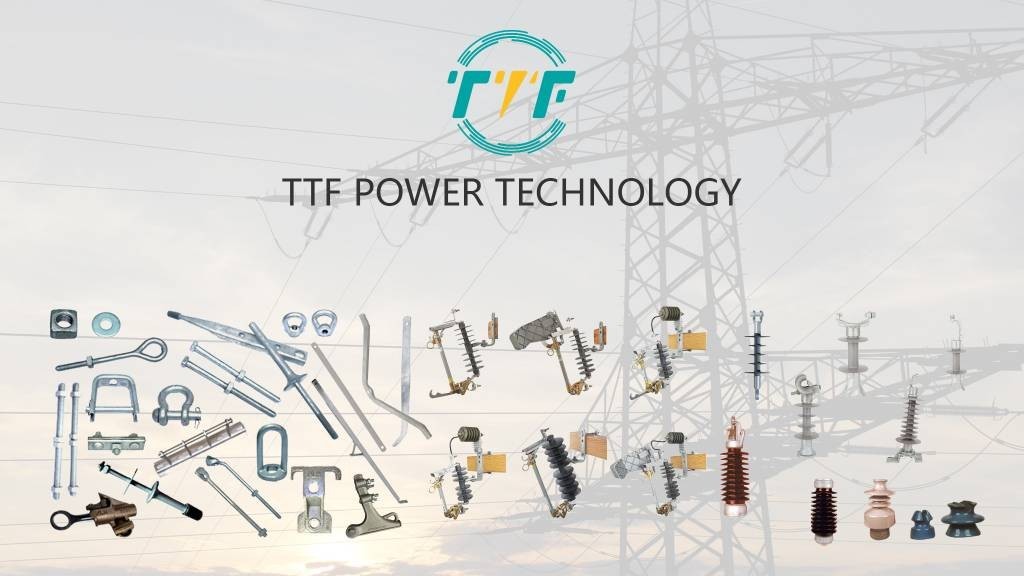
It is crucial to ensure the reliability, longevity, and safety of overhead power line systems. Applying the best practices helps prevent outages, reduce maintenance costs, and improve grid performance. This is crucial in medium- to high-voltage transmission and distribution networks. These practices include proper selection, current installation techniques, routine inspection and maintenance, design for environmental resilience, ensuring compatibility with other line hardware, and safe handling and storage. Following these standards helps ensure power line safety, reliability, and longer service life. These practices are also crucial for ensuring safety, reliability, and longevity in overhead power transmission and distribution systems. Additionally, following these practices helps maximize insulator lifespan, reduce outages, and enhance grid reliability.

